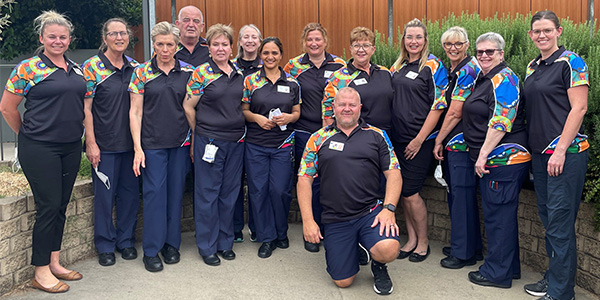Art is a key element to creating a culturally safe environment for Aboriginal patients. Learn how art is making a difference for patients, visitors and staff at local rehabilitation services in NSW.
My Rehab, My Journey – Gadjigadji is a co-designed web resource and toolkit aimed at improving the experience for Aboriginal people in rehabilitation services across NSW – in particular, those facing long hospital stays. Launched in 2021, the name comes from a Gamilaraay word meaning regrowth.
The resource addresses the need to create a culturally safe environment for Aboriginal people in rehabilitation, with an implementation toolkit, and education and clinical resources being used successfully in rehabilitation services.
“More than 40 rehabilitation services have actively adopted the resources as a team,” says Jenni Johnson, Stream Manager for Trauma, Pain and Rehabilitation at the Agency for Clinical Innovation (ACI). “We’ve also had many enquiries about how the resources might be adapted for other services, such as mental health, chronic disease management and community services.”
Art in practice
Art has been part of the Gadjigadji project from the beginning, with two works commissioned to represent the Aboriginal patient experience in rehabilitation. One was created by the renowned artist Aunty Cecily Wellington-Carpenter, who passed away in 2020, and another by proud Kunja woman Danielle Mate Sullivan. Both are available on the site as printable posters that can be displayed onsite at health services, and Danielle’s work is used across the website and resources. You can read more about the artists and download posters of their works.
The artwork and posters are an important element of the implementation toolkit being used in rehabilitation wards around NSW. Aboriginal patients have shared that seeing the posters or other indigenous artwork makes them feel welcome and recognised.

Starting a conversation in regional NSW
Danielle’s work has been used as a t-shirt design, proudly worn to raise awareness among staff by the Tamworth Rural Referral Hospital Rehabilitation Unit team.
“The t-shirts have been a great talking point for other staff who are interested in learning more about the program,” says team leader Karen Jenkins.
Amanda Styles, Clinical Nurse Consultant, Rehabilitation explains that staff education around clinical yarning and understanding the important role of Aboriginal Liaison Officers has been well received as part of the Gadjigadji implementation at Tamworth.

“People are sometimes reluctant to lead in with questions about Country, but it’s the right way to approach it,” adds Karen. “It’s important to sit down with the patient, show you’re taking the time and begin that respectful relationship before you ask what Country they’re from and start building connections.”
Creating a culturally responsive environment
Claudia Marshall, an occupational therapist who is heading up the Gadjigadji working group at Royal Rehab in Northern Sydney Local Health District (LHD) describes how the team used the Gadjigadji assessment and planning tools to audit the service. “This year we’ve established ward champions and aim to focus on developing a more culturally responsive environment, including renovating the carers’ lounge to offer a safe space for families and the community; and we’re engaging with Bush to Bowl to establish a bushtucker garden.”
Melinda Flower, a Kalkadoon and Miriam woman, works with the team at Royal Rehab supporting patients who identify as Aboriginal orTorres Strait Islander. Melinda works across the district as the Aboriginal Liaison Officer and Aboriginal and Torres Strait Islander Health Service Education Manager. When advising clinicians working with Aboriginal and Torres Strait Islander patients, she says clear, calm communication and keeping an open mind are key to cultural understanding.
If an Aboriginal or Torres Strait Islander person is speaking with you, reduce misunderstanding by considering the context of what they are saying in relation to them, their family, culture, where they live and the support services available to them. Ask open questions if you need more information: interpretations can differ due to verbal and non-verbal language, and conversations about spiritual and emotional wellbeing that may not be familiar to you.
Melinda also highlights the role that the arts can play when delivering patient-centred care for Aboriginal and Torres Strait Islander patients, both virtually and in the physical environment.
Melinda sends music and virtual art exhibitions by Aboriginal and Torres Strait Islander artists to patients via text message or email, assisting them with their healing journey by connecting through reminisce about country, family and friends. It also helps to generate conversations with those around them. Patients are also able to watch Aboriginal and Torres Strait Islander movies and documentaries using iPads (funded through a North Foundation grant) as well as engage with apps including NITV, Welcome to Country and Koori Radio.
Get involved with Gadjigadji
If you’re looking to improve the way your rehabilitation or other health service engages with Aboriginal patients, explore the My Rehab, My Journey – Gadjigadji website and resources. Take small steps, get a few team members together and get started.